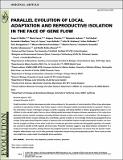Por favor, use este identificador para citar o enlazar a este item:
http://hdl.handle.net/10261/294857COMPARTIR / EXPORTAR:
 SHARE SHARE
 CORE
BASE CORE
BASE
|
|
| Visualizar otros formatos: MARC | Dublin Core | RDF | ORE | MODS | METS | DIDL | DATACITE | |

| Título: | Parallel evolution of local adaptation and reproductive isolation in the face of gene flow |
Autor: | Butlin, R. K.; Saura, María CSIC ORCID; Charrier, G.; Jackson, B.; André, C.; Caballero, A. CSIC ORCID; Coyne, J. A.; Galindo, Juán; Grahame, J. W.; Hollander, J.; Kemppainen, P.; Martínez-Fernández, Mónica; Panova, M.; Quesada, H.; Johannesson, K.; Rolán-Alvarez, Emilio | Palabras clave: | Gene flow Local adaptation Parallel evolution Speciation |
Fecha de publicación: | 2014 | Editor: | John Wiley & Sons | Citación: | Evolution 68(4): 935-949 (2014) | Resumen: | Parallel evolution of similar phenotypes provides strong evidence for the operation of natural selection. Where these phenotypes contribute to reproductive isolation, they further support a role for divergent, habitat-associated selection in speciation. However, the observation of pairs of divergent ecotypes currently occupying contrasting habitats in distinct geographical regions is not sufficient to infer parallel origins. Here we show striking parallel phenotypic divergence between populations of the rocky-shore gastropod, Littorina saxatilis, occupying contrasting habitats exposed to either wave action or crab predation. This divergence is associated with barriers to gene exchange but, nevertheless, genetic variation is more strongly structured by geography than by ecotype. Using approximate Bayesian analysis of sequence data and amplified fragment length polymorphism markers, we show that the ecotypes are likely to have arisen in the face of continuous gene flow and that the demographic separation of ecotypes has occurred in parallel at both regional and local scales. Parameter estimates suggest a long delay between colonization of a locality and ecotype formation, perhaps because the postglacial spread of crab populations was slower than the spread of snails. Adaptive differentiation may not be fully genetically independent despite being demographically parallel. These results provide new insight into a major model of ecologically driven speciation. © 2013 The Authors. Evolution published by Wiley Periodicals, Inc. | URI: | http://hdl.handle.net/10261/294857 | DOI: | 10.1111/evo.12329 | ISSN: | 0014-3820 | E-ISSN: | 1558-5646 |
| Aparece en las colecciones: | (INIA) Artículos |
Ficheros en este ítem:
| Fichero | Descripción | Tamaño | Formato | |
|---|---|---|---|---|
| 8923c1b4-e698-4c82-b928-f7d271903dfa.pdf | 575,94 kB | Adobe PDF |  Visualizar/Abrir |
CORE Recommender
PubMed Central
Citations
60
checked on 29-abr-2024
SCOPUSTM
Citations
133
checked on 24-abr-2024
WEB OF SCIENCETM
Citations
130
checked on 24-feb-2024
Page view(s)
25
checked on 01-may-2024
Download(s)
30
checked on 01-may-2024

